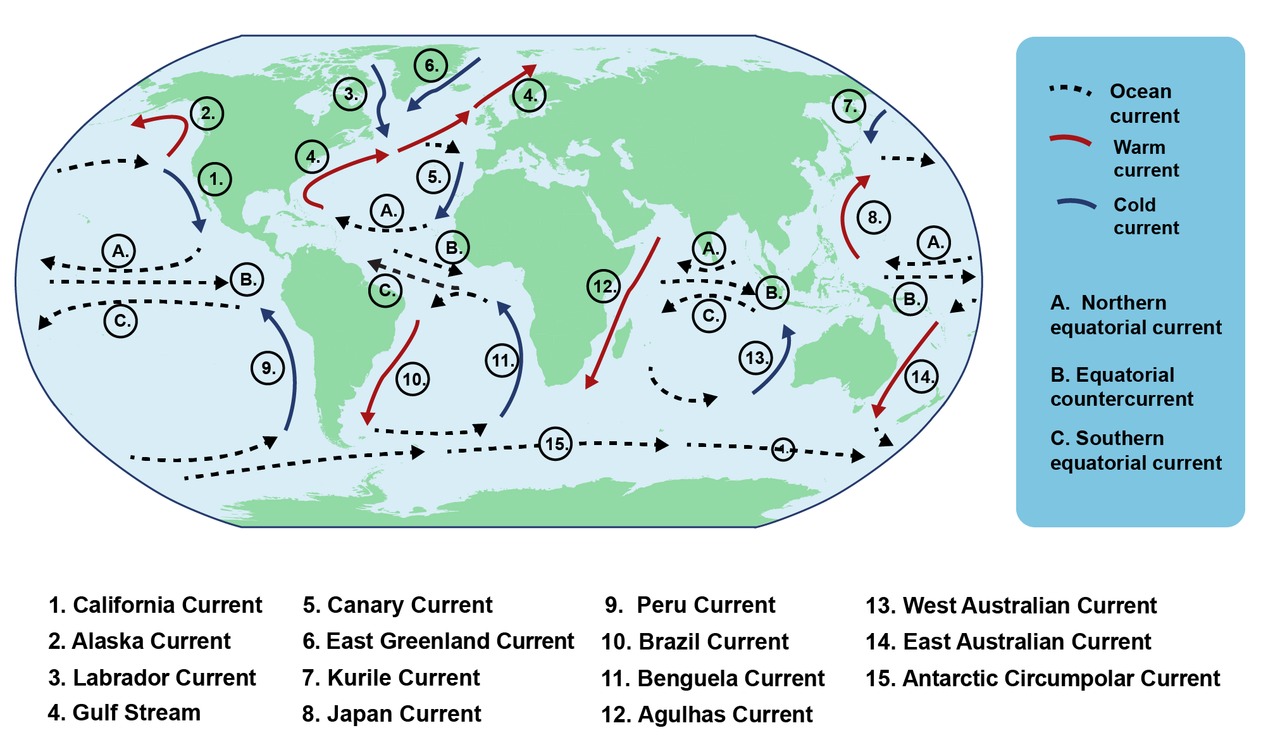8.2 The Finnish climate
The Finnish climate is influenced by three main factors. The first and most important factor is Finland's location in the Northern Hemisphere. Finland is located between the 60th and 70th northern latitudes, which means that solar radiation arrives at the surface of the Finnish earth from a slanted angle. This means that Finland receives significantly less light and warmth per square kilometer than places that are located closer to Earth's equator. As a result, Finland is part of the temperate geographic zone.
The second factor that influences Finnish climate is our proximity to the Atlantic Ocean and its warm Gulf Stream. The Gulf Stream is an ocean current that brings warm water and air from the areas near the Florida coast towards the North Sea. The Gulf Stream has a significant effect on Finnish climatic conditions, as without its warming effects our climate would be much colder and more similar to places like Siberia and Canada, which are located on approximately the same longitudes as Finland.
When southwesterly winds blow towards Finland, they bring us warm air from above the Gulf Stream. This helps to increase the average yearly temperature by approximately 6 degrees.
 The major ocean currents of planet Earth. The red arrows indicate warm currents, whereas blue arrows indicate cold currents.
The major ocean currents of planet Earth. The red arrows indicate warm currents, whereas blue arrows indicate cold currents.
The third factor that contributes to the Finnish climate is the proximity of the great Asian continent to our east. The inner parts of the Asian continent experience a continental climate. During the winter the continent grows cold, which results in easterly and northeasterly winds that bring sunny yet cold winter weather to Finland. During the summer, the Asian continent warms up slowly but surely, and southeasterly winds bring us warm summer weather.
Because the Finnish climate displays features of both maritime and continental climates, it is an example of an intermediate climate.
However, because Finland is a vast country, the climatic conditions are not same everywhere. The Southwestern parts of the nation are more temperate due to the warming effect of the Baltic Sea, which also causes the summers in these parts to be slightly colder than in inland regions.

The Finnish climate is an example of an intermediate climate. The winter is not as cold as in areas further inside the continent, but the summer is also not as warm as in these inner parts. This climate diagram presents the yearly average temperature and precipitation of the city of Jyväskylä.
The second factor that influences Finnish climate is our proximity to the Atlantic Ocean and its warm Gulf Stream. The Gulf Stream is an ocean current that brings warm water and air from the areas near the Florida coast towards the North Sea. The Gulf Stream has a significant effect on Finnish climatic conditions, as without its warming effects our climate would be much colder and more similar to places like Siberia and Canada, which are located on approximately the same longitudes as Finland.
When southwesterly winds blow towards Finland, they bring us warm air from above the Gulf Stream. This helps to increase the average yearly temperature by approximately 6 degrees.
 The major ocean currents of planet Earth. The red arrows indicate warm currents, whereas blue arrows indicate cold currents.
The major ocean currents of planet Earth. The red arrows indicate warm currents, whereas blue arrows indicate cold currents.The third factor that contributes to the Finnish climate is the proximity of the great Asian continent to our east. The inner parts of the Asian continent experience a continental climate. During the winter the continent grows cold, which results in easterly and northeasterly winds that bring sunny yet cold winter weather to Finland. During the summer, the Asian continent warms up slowly but surely, and southeasterly winds bring us warm summer weather.
Because the Finnish climate displays features of both maritime and continental climates, it is an example of an intermediate climate.
However, because Finland is a vast country, the climatic conditions are not same everywhere. The Southwestern parts of the nation are more temperate due to the warming effect of the Baltic Sea, which also causes the summers in these parts to be slightly colder than in inland regions.

The Finnish climate is an example of an intermediate climate. The winter is not as cold as in areas further inside the continent, but the summer is also not as warm as in these inner parts. This climate diagram presents the yearly average temperature and precipitation of the city of Jyväskylä.